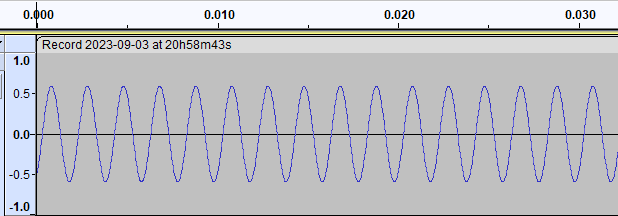pulse rate - diglet48/restim GitHub Wiki
We will discuss:
- Traditional signal generation.
- Pulsed signals.
- Traditional modulation by mixing multiple carrier signals.
- Various signal generation ideas.
Traditional signal generation
Traditionally, e-stim signals are just sine waves, the frequency is called the carrier frequency.

These signals are not efficient, they stimulate the nerves are much higher rates than the nerves can physically generate action-potentials. As a result, energy efficiency is low.
Pulsed signals
One improvement is to modulate the signal, this reduces the signal energy but keeps the nerve activation almost the same. In some cases this may even increase the nerve activation because a constant signal can cause neuronal inhibition and/or rapid energy depletion.

(Signal generated by Restim, 500hz carrier, 50hz amplitude modulation, 0.50 low bias)
Most commercial devices use square pulses.
How fast should we fire these bursts?
If we fire bursts very slowly, most nerves will have recovered in time for each burst. The brain will interpret each burst as a separate event and this will feel like consistent low-frequency vibration. This happens below 30-35hz.
If bursts are fired faster, but not quite fast enough to feel fully smooth, the vibration will feel more random. In literature this is known as flutter.
Around 55-65hz, the bursts will merge together and it will feel fully smooth. The critical timing appears to be related to the length of silence between the bursts, not the burst frequency.
If we fire bursts even faster, the nerve endings directly under the electrode surface will hit their maximum firing rate. This occurs around 100-200hz stimulation. It is thought that stimulating at this higher rate activates nerves in a larger area compared to lower frequency stimulation at normalized intensity. It is currently not known if this affects the sensation.
A smoother feeling waveform does not always feel better. One time I tested 80hz vs 40hz pulses. The 80hz pulsetrain was smoother, but it also felt a bit harsh and slightly painfully, the lower frequency waveform was more gentle and arousing at similar perceived volume. Test to see what works for you.
Below is supportive data.

Intensity of various pulse frequencies, experiments performed by myself.
Breakpoints around 35hz and 55hz clearly visible.
I found transition point from 'vibration' to 'smooth' around 55hz.
This paper has a very different methodology but finds similar breakpoints for frequency discrimination. This paper suggests that everything that happens withing the 'burst duration' of 10-25ms is merged together. Temporal patterns in electrical nerve stimulation: Burst gap code shapes tactile frequency perception
The following paper has data on instrumented rat brains showing that 100hz and 200hz stimulation results similar nerve activation for individual nerves. This shows an upper limit in the activation rate of individual nerves. Axonal Stimulations With a Higher Frequency Generate More Randomness in Neuronal Firing Rather Than Increase Firing Rates in Rat Hippocampus
Finally, this paper has data on primates showing that activation rate (spike count) of a group of nerves increases all the way until 1000hz. A computational model that predicts behavioral sensitivity to intracortical microstimulation
Restim offers various ways to control the modulation shape. This needs additional research.
It works different for muscles, also needs research.
Additional reading: https://gitlab.com/mantrid0/mpgenerator/-/blob/master/Readme.md#the-theory
Multiple carrier signals
Some software uses multiple carrier signals, such as 420Hz + 520Hz + 620Hz. This is mathematically the same as amplitude modulation, just more confusing. See product-to-sum formula on wikipedia.
Various signal generation ideas
Varying pulse rate
Rather than stimulating with a constant 100hz pulse rate, some academics are running experiments
where they vary the inter-pulse-interval (IPI).
One approach is to randomize the IPI between 5-10ms. This seems to have the effect of slowing
numbing significantly. In my testing, such signal causes a slightly tingly sensation.
https://www.frontiersin.org/articles/10.3389/fnins.2020.00397/full
https://www.mdpi.com/2076-3425/11/4/509
A different approach would be to stimulate with a constant 100hz pulse rate, but randomly omit a pulse,
or insert one extra pulse.
https://iopscience.iop.org/article/10.1088/1741-2552/acb013/meta
More testing is needed, but the following effects of random IPI have been mentioned:
- Slightly more tingly sensation
- Less painful when suddenly increasing the volume or with fast movements
- Feels slightly more natural in long sessions
- Slows down numbing
Varying intensity
Instead of randomly varying the IPI, we can also randomly vary the amplitude of individual pulses. Needs research.